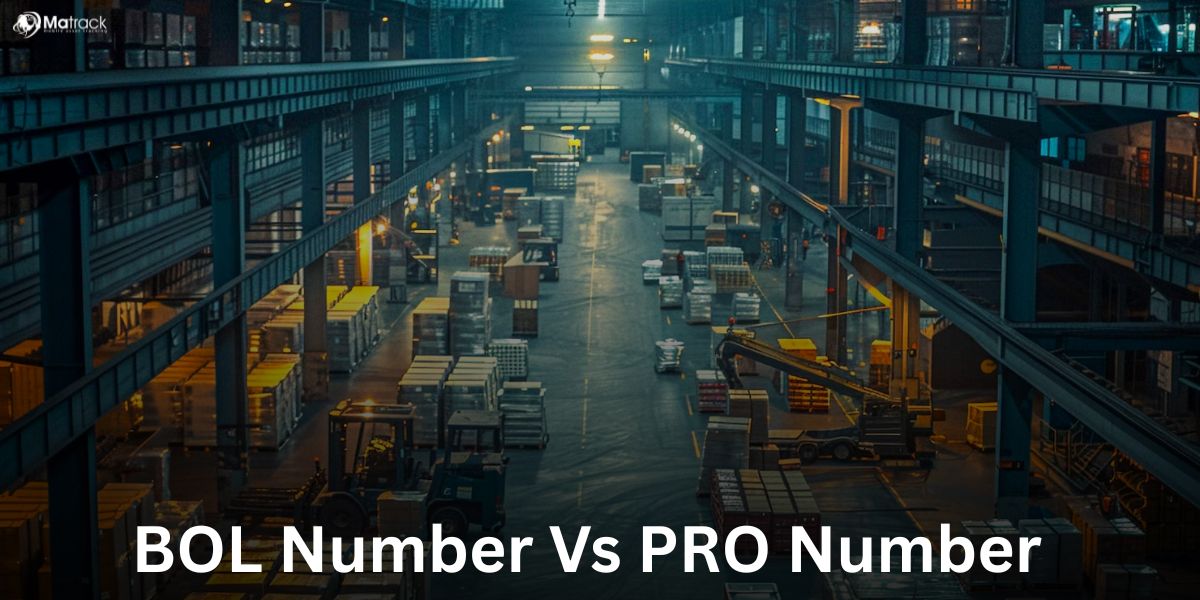Key Takeaways
- A BOL number connects to the legal shipping document and defines what is being shipped, where it’s going, and under what terms.
- A PRO number tracks the physical movement of each shipment unit and updates its location throughout transit.
- Both numbers are assigned by different parties and used at different stages but remain linked in shipment records.
- Using BOL and PRO numbers together improves accuracy in tracking, billing, documentation, and customer communication.
What Is A BOL Number?
A BOL number is a unique identifier assigned to a Bill of Lading, which serves as a legal document between a shipper and a carrier. This number links to all key shipment details, including the origin, destination, cargo description, and service terms.
Carriers, customs, and receivers use the BOL number to verify shipment legitimacy and match physical goods with official documentation. Accurate use of the BOL number ensures smooth handling, claim validation, and proper freight release at every checkpoint.
BOL Number Properties
- Alphanumeric format
- Shipper-generated or system-generated
- Remains constant across shipment lifecycle
What Is A PRO Number?
A PRO number is a carrier-assigned numeric code used to track the real-time movement of a specific shipment. It identifies each freight unit independently, allowing visibility throughout the shipping process.
The PRO number appears on shipping labels and is scanned at each transit point to update status. This tracking ensures accurate delivery timelines, supports billing, and helps resolve shipment-related issues quickly.
PRO Number Properties
- Numeric format (7–10 digits)
- Assigned by carrier at pickup
- Scannable and trackable via barcode
What Are The Differences Between BOL Number And PRO Number?
Understanding the difference between a BOL number and a PRO number is important for anyone involved in shipping and logistics. Both numbers are used in the same shipment process, but they serve completely different purposes and are handled by different parties.
1. Purpose and Function
A BOL number is directly tied to the Bill of Lading, which is the official document that outlines the details of a shipment. It represents the legal agreement between the shipper and the carrier, covering what is being shipped, where it is going, and under what terms.
On the other hand, a PRO number is used for tracking the physical movement of the shipment while it’s in transit. It helps identify the shipment’s location, status updates, and delivery progress from the moment the carrier picks it up.
2. Who Assigns the Number
The BOL number is created by the shipper or freight broker at the beginning of the shipping process. It stays the same from start to finish and is included in all official documents.
The PRO number is assigned by the carrier once the freight is picked up. If a shipment includes multiple packages or pallets, each one may have its own PRO number, even if they all fall under the same BOL.
3. Where Each Number Appears
You will find the BOL number printed on the actual Bill of Lading document, which travels with the shipment and is often required by customs or insurance. This document is a key reference point throughout the entire shipping process.
The PRO number is printed on the shipment label, usually as a barcode, and is used by the carrier to scan and track the shipment at different checkpoints. It’s the number most people use when checking delivery updates online or through customer service.
4. Communication and Usage
The BOL number is often used in conversations that involve documentation, customs clearance, or legal questions. It’s the reference number for claims, shipment disputes, and verification of shipping terms.
The PRO number is more useful for tracking the shipment’s current status or expected delivery time. Carriers and customers rely on it to monitor where the shipment is and when it will arrive.
5. Format and Structure
BOL numbers usually contain letters and numbers. Their format depends on the shipper’s system and may include booking or reference codes.
PRO numbers are always numerical and generally contain between seven and ten digits. They are formatted for easy scanning and entry into tracking systems.
How BOL And PRO Work Together?
Shipment Begins
The BOL number is created when the shipper prepares the Bill of Lading for the freight. It holds all legal and shipment details, acting as the official document for the entire delivery process.
Tracking Starts
Once the carrier picks up the freight, they assign a PRO number to track its physical movement. This number is used to scan and update the shipment’s status at every stage.
Linked in Systems
Both BOL and PRO numbers are linked within the carrier’s tracking system. This connection ensures that every movement update is tied back to the original shipping document.
Used Together
The BOL number verifies what’s being shipped, while the PRO number confirms where it is. Together, they provide full visibility and control throughout the shipping journey.
When To Use BOL Number Vs PRO Number?
Use the BOL Number for:
- Legal claims
- Customs clearance
- Insurance documentation
- Contract verification
- Shipment disputes
Use the PRO Number for:
- Shipment tracking
- ETA notifications
- Terminal updates
- Billing and invoices
- Customer service follow-ups
What Are The Common Errors And Preventions?
| Error | Prevention Strategy |
| Wrong PRO used for tracking | Validate via carrier portal |
| Missing BOL number in claims | Digitally archive all BOLs |
| Incorrect BOL on shipment paperwork | Use system-generated BOLs |
| PRO mismatch on freight invoice | Integrate TMS with billing system |
Final Verdict
The BOL number and PRO number play separate but equally important roles in freight logistics. While the BOL number handles the legal and contractual side of the shipment, the PRO number manages tracking and delivery visibility.
Using these numbers correctly ensures smoother communication between shippers, carriers, and consignees. It also reduces the risk of documentation errors, billing issues, and shipment delays.
Both identifiers should always be stored, referenced, and validated together for complete shipment control. When used accurately, they bring clarity, accountability, and efficiency to every stage of the shipping process.



